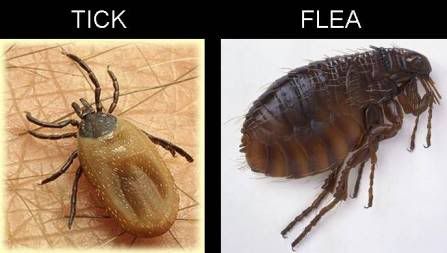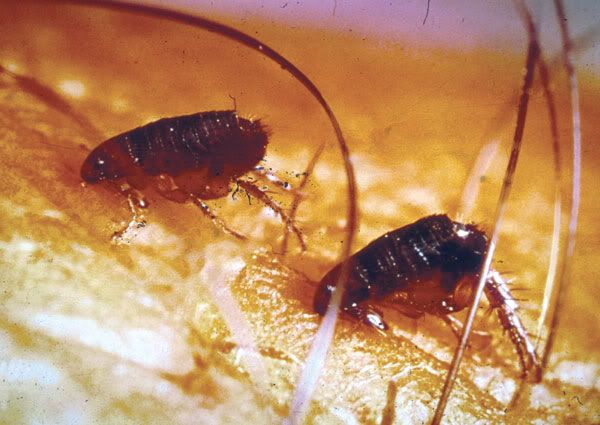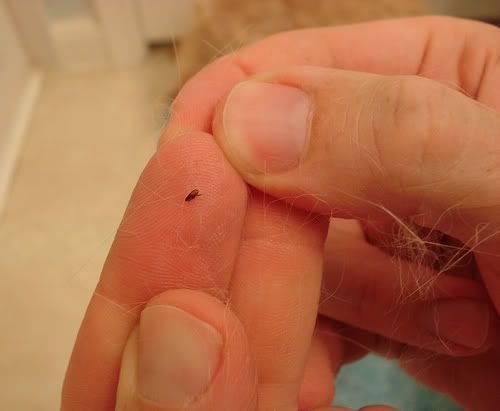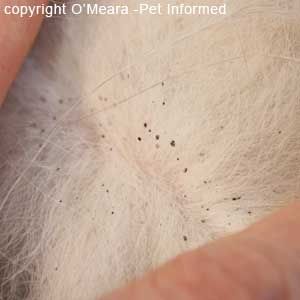Post by CampGreyhound on Mar 20, 2011 9:43:12 GMT -5
If you're interested in keeping chemicals and pesticides away from your home, family and pets, but you don't want to have a flea infestation, then now's the time to start planning. If you have cats and they go outside, they are notorius carriers for fleas into the house, so intensify your efforts on them. They are like the canary in the coal mine, likely because they are very close to the ground.
FLEA DEFENSE CHECKLIST
Flea Comb- Pet store or vet clinic.
Diatomacous Earth - Food grade only! Smarter pet stores are starting to carry it, we carry it in our webstore in 3 sizes and ship it as well. Some farm co-ops carry the agricultural grade, this is only good for use in the yard. You will need the food grade to apply to your pet.
Flea Repellent - The grocery store has everything you need to make your own. We carry a pre-made one seasonally in our webstore, as do many of the better pet stores, but make sure you know what's in them!
Pet Shampoo - Ask a groomer if you can purchase some from her, the pet stores carry very poor quality shampoo.
What Am I Looking For?
You may or may not see fleas, which from a lateral view look like this:




They are very flat, and they move pretty quickly and can be difficult to catch.
Their dirt, however, is pretty easy to spot. Use test #1 to confirm that it's flea dirt and not regular dirt from playing outside.



Flea comb or fine comb
For checking your animals periodically, especially after they've been outside and/or in contact with other animals. If you're proactive about this and check regularly and carefully, you can save yourself a lot of work. Getting rid of one or two fleas is easy, dealing with an infestation is going to take a chunk of your time and effort! Use the comb around the ears, at the base of the tail, and on the tummy and around the groin area. Fleas like warm, moist places!
Flea Test #1
Another highly effective method to check your dog or cat, especially if they've been scratching alot, is to have them stand over a white piece of paper and rub them where they've been scratching. Typically that means around the ears, at the base of the tail, and around the groin area. When your dog steps away, you'll see bits of hair and dirt on the paper. Use a damp cloth, or even just wet your finger and run it through any specks of dirt. If you get a red streak, that means there's flea poop on your dog, and he's got fleas.
Flea Test #2
A good test for your home, to see if you have any fleas hanging about. Fleas love heat and humidity, so pick a room where your dogs have been hanging around, and overnight put a bowl of water with a squirt of dish soap in it on the carpet, and grab a desk lamp so you can shine a light on the bowl. Leave the light on overnight, and check for fleas floating in the bowl in the morning.
Bath Time
Once you've confirmed there are fleas on your dog, it's time to go into action. If you've just got a few, you have a very good chance of nipping the problem in the bud quickly. A bath is the quickest way to kill any fleas that are on your dog, and you don't need to use a shampoo with pesticides to do it. Any good quality dog shampoo will work so long as you keep the suds on a good 10-15 minutes. So lather him up and rub away. When time is up, rinse well and watch the rinse water to see if he's just got a few or he's loaded up. Even just a few fleas can mean lots of eggs, so scrub well, the eggs are sticky!
Vacuum, Vacuum, Vacuum
We're not kidding, this is the best tool for dealing with a flea problem. Over 95% of fleas can be killed with this simple tool, and it doesn't have any side effects whatsoever! You will vacuum up both fleas and eggs, along with any larvae that might be lurking. If your dog sleeps on your couch, don't forget to vacuum it thoroughly too. All carpets, baseboards, and any areas your dog or cat frequents should be vacuumed. Just one flea can lay a whole ton of eggs, so if you're thorough with this step you can save yourself a whole lot of grief in 30 days - that's when any lurking eggs will hatch! If you've just found a few fleas on your dog or cat, at this point you can dial it down and go into monitoring mode. If you've found a lot of fleas on your dog, we recommmend vacuuming every day for 30 days or until you're sure there are no more eggs.
Vacuum Bag Storage: Rather than changing your vacuum bag every day, we recommend putting it in a garbage bag and storing it in the deep freezer if you have one - that will kill any fleas in the bag. After the first day, you'll likely have some DE in the bag too, a little extra insurance. If you don't have a deep freezer, ensure you seal the bag inside a secure plastic bag or fleas will be escaping out of it!
WASH
Along with the dog (or cat), you'll need to wash any bedding they've been on, and vacuum your mattress too. If there are clothes on the floor, grab them too!
Food Grade Diatomaceous Earth
Also called Fossil Sea Shell Flour, (you can read more about this non-chemical product in other threads on this forum) can be a huge help in keeping fleas off your pets, both before and after they arrive there. If used beforehand, it creates a very dry enviroment that the fleas don't like, they prefer moist areas. If used to deal with fleas already on your pet, it will kill them through mechanical action. This can take up 1-2 days, although we've found it generally acts more quickly than that. You can use DE sparingly, take a small handful and apply it to the base of the tail , around the ears (carefully avoiding the eyes) and the groin area. I also do the legs. Try not to create a cloud of DE when you're applying it - it's non-silica so it's not harmful to the lungs in these quantities, but it's not pleasant to breath in! Apply outside or you'll have a big mess.
You'll notice your pet feels dryer in the areas where you've applied the DE - the fleas will notice this too! DE is completely safe for your dog or cat to ingest, it's already in use in our grain elevators and has been since the 1950's. Many people use it as a supplement internally as it provides many trace minerals. We re-apply DE every 2-3 days during flea season. I recommend letting your dog spend some time outside after you've applied it, so that any surplus falls off outside.
If you're dealing with an infestation in the house, DE is a good tool for the house too! We put DE inside dog beds, in the cracks of the couch, and sparingly work it into the carpet after vacuuming. A little goes a long way, you don't need a whole lot! You can apply it to the carpet once you're sure you have all eggs and fleas out of the area.
You can also apply DE outside the house, but be judicious in it's use, as it can kill beneficial insects as well. We use it in the big sandy area where our dogs dig, and that's it.
Monitoring/Prevention Stage
To keep on top of your flea-free status, use your flea comb (available at any pet store) and be vigilant. If you're suspicious, you can use the flea tests outlined above to check the status of your pet and home. With fleas, it's important to be pro-active, every day you wait can mean hundreds more to deal with.
Keep your grass cut shorter where your pets hang out in the yard. With shorter grass comes lower humidity, and the fleas don't like that.
During walks, keep your distance from other pets if you don't know their flea status. Try to stay away from areas where dogs congregate. Arrange playdates with dogs you know rather than going to the dog park. This will help prevent internal parasites as well!
Use a flea repellant that you made yourself, or that you are sure has no chemicals or essential oils (many are toxic). Recipe can be found at the bottom of this post.. Use your spray on your pet every time he or she goes out.
While it's a contentious issue as to whether or not raw fed dogs are less likely to get fleas, we believe that a species appropriate diet is the first step in having a healthy pet, and it certainly lessens the chances of a bad infestation if you are feeding at least partly raw.
If you've done everything outlined and you're still having problems, that's the appropriate time to start looking at some of the less toxic chemical methods. Please don't use these chemical methods on your pet "just in case" - some have very serious side effects! The "spot on" products are the worst. If nothing else has worked, we recommend Capstar.
FDA Information can be found here:
www.fda.gov/downloads/AnimalVeterinary/Products/ApprovedAnimalDrugProducts/FOIADrugSummaries/ucm117258.pdf
Capstar is the lesser of all evils, as it does not have a prolonged effect and it knocks down the fleas quickly. There appears to be none of the side effects with Capstar that there are with products like Frontline and Advantage.
Capstar can be purchased here:
Pets Megastore
Flea Repellent Recipe
Slice one lemon thinly, put in a mason jar and cover with boiling water. Add a few sprigs of rosemary or peppermint, and let sit for several hours or days. Keep in fridge, and strain some through a strainer to fill a small spray bottle as needed. Apply regularly to your pet to help ward off fleas - this will also help with mosquitoes!
We strongly recommend staying away from essential oils, they are not all safe on all pets and can be lethal to cats. It's very easy to transfer an essential oil from a dog to your hand to a cat, and it's just not worth taking a chance, when herbal teas and decoctions are just as effective. So please check your labels carefully, if you don't use a home made product.
Examples of a few commonly used essential oils that are toxic to pets include:
Pennyroyal: A popular ingredient in "Natural" bug sprays, both the herb and the oil are highly toxic to dogs and cats.
Tea Tree Oil: HIghly toxic to cats and smaller dogs, even larger dogs can react to the dilute version of this essential oil.
Comfrey: Can cause liver damage and cancer in large quantities
Wormwood: Toxic to both cats and dogs
We hope this helps!
FLEA DEFENSE CHECKLIST
Flea Comb- Pet store or vet clinic.
Diatomacous Earth - Food grade only! Smarter pet stores are starting to carry it, we carry it in our webstore in 3 sizes and ship it as well. Some farm co-ops carry the agricultural grade, this is only good for use in the yard. You will need the food grade to apply to your pet.
Flea Repellent - The grocery store has everything you need to make your own. We carry a pre-made one seasonally in our webstore, as do many of the better pet stores, but make sure you know what's in them!
Pet Shampoo - Ask a groomer if you can purchase some from her, the pet stores carry very poor quality shampoo.
What Am I Looking For?
You may or may not see fleas, which from a lateral view look like this:




They are very flat, and they move pretty quickly and can be difficult to catch.
Their dirt, however, is pretty easy to spot. Use test #1 to confirm that it's flea dirt and not regular dirt from playing outside.



Flea comb or fine comb
For checking your animals periodically, especially after they've been outside and/or in contact with other animals. If you're proactive about this and check regularly and carefully, you can save yourself a lot of work. Getting rid of one or two fleas is easy, dealing with an infestation is going to take a chunk of your time and effort! Use the comb around the ears, at the base of the tail, and on the tummy and around the groin area. Fleas like warm, moist places!
Flea Test #1
Another highly effective method to check your dog or cat, especially if they've been scratching alot, is to have them stand over a white piece of paper and rub them where they've been scratching. Typically that means around the ears, at the base of the tail, and around the groin area. When your dog steps away, you'll see bits of hair and dirt on the paper. Use a damp cloth, or even just wet your finger and run it through any specks of dirt. If you get a red streak, that means there's flea poop on your dog, and he's got fleas.
Flea Test #2
A good test for your home, to see if you have any fleas hanging about. Fleas love heat and humidity, so pick a room where your dogs have been hanging around, and overnight put a bowl of water with a squirt of dish soap in it on the carpet, and grab a desk lamp so you can shine a light on the bowl. Leave the light on overnight, and check for fleas floating in the bowl in the morning.
Bath Time
Once you've confirmed there are fleas on your dog, it's time to go into action. If you've just got a few, you have a very good chance of nipping the problem in the bud quickly. A bath is the quickest way to kill any fleas that are on your dog, and you don't need to use a shampoo with pesticides to do it. Any good quality dog shampoo will work so long as you keep the suds on a good 10-15 minutes. So lather him up and rub away. When time is up, rinse well and watch the rinse water to see if he's just got a few or he's loaded up. Even just a few fleas can mean lots of eggs, so scrub well, the eggs are sticky!
Vacuum, Vacuum, Vacuum
We're not kidding, this is the best tool for dealing with a flea problem. Over 95% of fleas can be killed with this simple tool, and it doesn't have any side effects whatsoever! You will vacuum up both fleas and eggs, along with any larvae that might be lurking. If your dog sleeps on your couch, don't forget to vacuum it thoroughly too. All carpets, baseboards, and any areas your dog or cat frequents should be vacuumed. Just one flea can lay a whole ton of eggs, so if you're thorough with this step you can save yourself a whole lot of grief in 30 days - that's when any lurking eggs will hatch! If you've just found a few fleas on your dog or cat, at this point you can dial it down and go into monitoring mode. If you've found a lot of fleas on your dog, we recommmend vacuuming every day for 30 days or until you're sure there are no more eggs.
Vacuum Bag Storage: Rather than changing your vacuum bag every day, we recommend putting it in a garbage bag and storing it in the deep freezer if you have one - that will kill any fleas in the bag. After the first day, you'll likely have some DE in the bag too, a little extra insurance. If you don't have a deep freezer, ensure you seal the bag inside a secure plastic bag or fleas will be escaping out of it!
WASH
Along with the dog (or cat), you'll need to wash any bedding they've been on, and vacuum your mattress too. If there are clothes on the floor, grab them too!
Food Grade Diatomaceous Earth
Also called Fossil Sea Shell Flour, (you can read more about this non-chemical product in other threads on this forum) can be a huge help in keeping fleas off your pets, both before and after they arrive there. If used beforehand, it creates a very dry enviroment that the fleas don't like, they prefer moist areas. If used to deal with fleas already on your pet, it will kill them through mechanical action. This can take up 1-2 days, although we've found it generally acts more quickly than that. You can use DE sparingly, take a small handful and apply it to the base of the tail , around the ears (carefully avoiding the eyes) and the groin area. I also do the legs. Try not to create a cloud of DE when you're applying it - it's non-silica so it's not harmful to the lungs in these quantities, but it's not pleasant to breath in! Apply outside or you'll have a big mess.
You'll notice your pet feels dryer in the areas where you've applied the DE - the fleas will notice this too! DE is completely safe for your dog or cat to ingest, it's already in use in our grain elevators and has been since the 1950's. Many people use it as a supplement internally as it provides many trace minerals. We re-apply DE every 2-3 days during flea season. I recommend letting your dog spend some time outside after you've applied it, so that any surplus falls off outside.
If you're dealing with an infestation in the house, DE is a good tool for the house too! We put DE inside dog beds, in the cracks of the couch, and sparingly work it into the carpet after vacuuming. A little goes a long way, you don't need a whole lot! You can apply it to the carpet once you're sure you have all eggs and fleas out of the area.
You can also apply DE outside the house, but be judicious in it's use, as it can kill beneficial insects as well. We use it in the big sandy area where our dogs dig, and that's it.
Monitoring/Prevention Stage
To keep on top of your flea-free status, use your flea comb (available at any pet store) and be vigilant. If you're suspicious, you can use the flea tests outlined above to check the status of your pet and home. With fleas, it's important to be pro-active, every day you wait can mean hundreds more to deal with.
Keep your grass cut shorter where your pets hang out in the yard. With shorter grass comes lower humidity, and the fleas don't like that.
During walks, keep your distance from other pets if you don't know their flea status. Try to stay away from areas where dogs congregate. Arrange playdates with dogs you know rather than going to the dog park. This will help prevent internal parasites as well!
Use a flea repellant that you made yourself, or that you are sure has no chemicals or essential oils (many are toxic). Recipe can be found at the bottom of this post.. Use your spray on your pet every time he or she goes out.
While it's a contentious issue as to whether or not raw fed dogs are less likely to get fleas, we believe that a species appropriate diet is the first step in having a healthy pet, and it certainly lessens the chances of a bad infestation if you are feeding at least partly raw.
If you've done everything outlined and you're still having problems, that's the appropriate time to start looking at some of the less toxic chemical methods. Please don't use these chemical methods on your pet "just in case" - some have very serious side effects! The "spot on" products are the worst. If nothing else has worked, we recommend Capstar.
FDA Information can be found here:
www.fda.gov/downloads/AnimalVeterinary/Products/ApprovedAnimalDrugProducts/FOIADrugSummaries/ucm117258.pdf
Capstar is the lesser of all evils, as it does not have a prolonged effect and it knocks down the fleas quickly. There appears to be none of the side effects with Capstar that there are with products like Frontline and Advantage.
Capstar can be purchased here:
Pets Megastore
Flea Repellent Recipe
Slice one lemon thinly, put in a mason jar and cover with boiling water. Add a few sprigs of rosemary or peppermint, and let sit for several hours or days. Keep in fridge, and strain some through a strainer to fill a small spray bottle as needed. Apply regularly to your pet to help ward off fleas - this will also help with mosquitoes!
We strongly recommend staying away from essential oils, they are not all safe on all pets and can be lethal to cats. It's very easy to transfer an essential oil from a dog to your hand to a cat, and it's just not worth taking a chance, when herbal teas and decoctions are just as effective. So please check your labels carefully, if you don't use a home made product.
Examples of a few commonly used essential oils that are toxic to pets include:
Pennyroyal: A popular ingredient in "Natural" bug sprays, both the herb and the oil are highly toxic to dogs and cats.
Tea Tree Oil: HIghly toxic to cats and smaller dogs, even larger dogs can react to the dilute version of this essential oil.
Comfrey: Can cause liver damage and cancer in large quantities
Wormwood: Toxic to both cats and dogs
We hope this helps!

